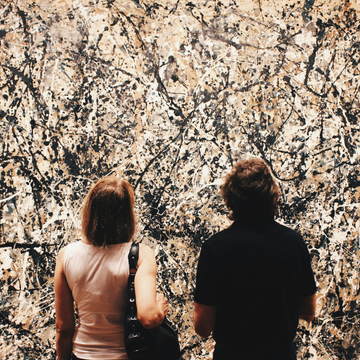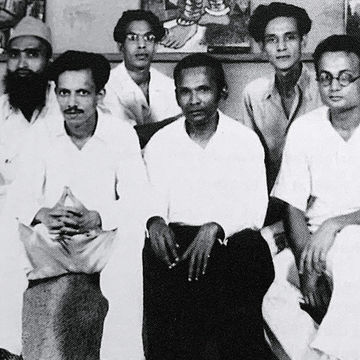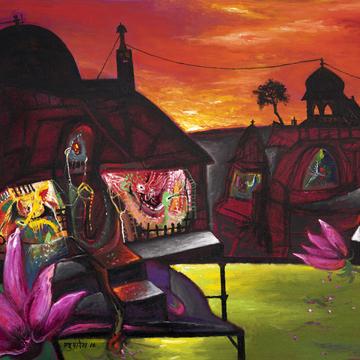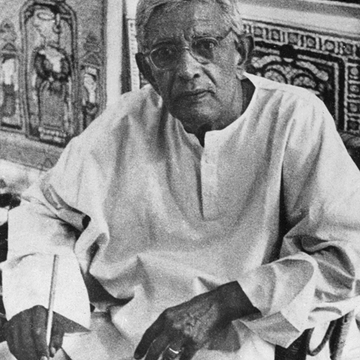When did Art become Abstract?

Abstract art can be simply understood as an art form that is separate from reality. The word itself indicates something that is evasive and not entirely rooted in the physical world that we inhabit. Alternatively, it can also be interpreted as the true vision of reality, rather than its opposite.
Author - Ria Sarkar
“The only way to say what abstract is, is to say what it is not.”
(Ad Reinhardt)
Abstract art can be simply understood as an art form that is separate from reality. The word itself indicates something that is evasive and not entirely rooted in the physical world that we inhabit. Alternatively, it can also be interpreted as the true vision of reality, rather than its opposite.
The origin of abstraction as a concept can be traced back to the art movements that erupted in Europe, Russia and America as a result of the two world wars. During that period, artists found new ways of challenging the accepted notions of traditional art and imagery. They no longer wanted to abide by the age old methods of imitating reality and instead chose to break the shackles of what is understood as ‘representational’ art, or art that comprises of naturalistic depictions of forms, figures and shapes existing around us.
Starting with Impressionism in the late 1890’s, where artists took to painting ‘impressions’ of various things, Abstraction was the art world’s culmination of features developed through every 20th century art movement so to speak. In hindsight, Post-expressionism and Cubism are considered to be the direct precedents of the formation of Abstract art as a genre.
Geometric Abstraction
Post-WWI Europe and Russia witnessed the rise of geometric abstraction, a term coined to describe the linearity of form and space that characterises the works of artists adhering to this particular genre. Simple geometric forms are placed in a non-illusionistic space and combined into non-objective compositions. In other words, the long standing tradition of art history that was informed by Plato’s theory of mimesis, or ‘imitation of reality’, is broken down to create two-dimensional images in an attempt to re-construct the former in a novel way. It evolved from the Cubist formulae developed by Pablo Picasso and Georges Braque of showing a single subject from multiple angles in a two dimensional frame. Geometric abstraction was meant to simplify form and structure in a painting to basic shapes arranged in various asymmetric combinations as part of a visually unrealistic space.
This practice of devising a purely pictorial reality built of elemental geometric forms assumed different stylistic expressions in various European countries and in Russia. Among the pioneers was Piet Mondrian (1872-1944) from Holland, hailed as the most important proponent of geometric abstract language. Mondrian intended to create ‘absolute reality’ in his works by removing all references to the real world, conceived through a geometric division of the canvas through black vertical and horizontal lines of varied thickness, complemented by blocks of primary colours, particularly blue, red, and yellow. In his words, “Vertical and horizontal lines are the expression of two opposing forces; they exist everywhere and dominate everything; their reciprocal action constitutes ‘life’.” Mondrian developed this geometric style between 1915 and 1920, calling it ‘Neoplasticism’ and continued working with it consistently for the next two and a half decades.

Composition II in Red, Blue and Yellow’ exemplifies the basic tenets of the Di Stijl movement that Mondrian and his fellow Dutch painter Theo van Doesburg co-founded in 1917. Using only the primary colours (red, blue, and yellow), the primary values (black, white, and grey), and the primary directions (horizontal and vertical), the painting is meant to reveal universal harmony and order. To the layman, they may come across as colours and lines arranged together arbitrarily, but it is important to note the motive behind such artworks rather than their appearance. Mondrian created a substantial body of work that gave a definite direction to Abstract Art. He sought to achieve the ‘destruction of natural appearance’, finding instead ‘the plastic expression of true reality’.

Around the same time in Russia, avant-garde artist Kazimir Malevich (1879–1935) developed a similar geometric style in 1915, which he termed as Suprematism. Malevich’s interpretation involved creating nonobjective compositions of elemental forms seen floating in white unstructured space. Like Mondrian, he also strove to achieve “the absolute,” the higher spiritual reality that he called the “fourth dimension.”
The painting below by Malevich is called ‘The Black Square’ (1915) and is claimed by the artist to be the first of its kind, i.e. an original work without any attribute of real life. While his claim is disputed owing to the fact that Mondrian’s geometric compositions were made at the same time, he did create his own signature style by giving supremacy to colour itself, rather than a subject from real life. A broad white linen border surrounds a jet-black square of paint. Made in the backdrop of World War I, for Malevich it represents the dawn of a new age; a journey back to the basics, ‘Square one’ or ‘point zero’.
He went on to using the black square as a motif in myriad ways and forms in his subsequent works.

Abstract Expressionists
The aftermath of the second world war led many European artists to seek refuge in the United States, primarily in New York, chief among them being stalwarts like Dali, Breton, Mondrian, and Léger. This led to opening up of new avenues for viewing avant-garde art that featured groundbreaking temporary exhibitions of these migrated artists, including Cubism, Abstract Art, Fantastic Art, Dada and Surrealism.
The exposure to European art movements and concepts, especially abstraction set the stage for the most advanced American art developed in the Post-modern era. The group of artists that came to be known as “Abstract Expressionists” or “The New York School” succeeded in creating a stylistically diverse body of work that introduced radical new directions in art. The movement effectively shifted the art world’s focus from Europe to America in the postwar years.
While there are no clearly defined categories in which we may classify their works, the Abstract Expressionists played around with three main features – creating a unique artists’ signature through immediacy of expression; using colour itself as the primary subject (Suprematism) and emphasis on monumental scaled works. They were meant to be seen in close proximity, so that the viewer was virtually enveloped by the experience of confronting the work.
In 1952 critic Harold Rosenberg coined the term “action painting” to mark the performative nature of abstract expressionism. He said, “At a certain moment the canvas began to appear to one American painter after another as an arena in which to act—rather than as a space in which to reproduce, re-design, analyze, or ‘express’ an object, actual or imagined. What was to go on the canvas was not a picture but an event.”

Jackson Pollock (1912-1956) is the best example of an abstract expressionist who defines ‘action paintings’ in form and spirit. In 1947, he developed a radical new technique of pouring or flicking paint onto a canvas laid on the ground. He would let it dribble and splatter, but he did it in a pattern and precision with the flick of his wrist, letting the paint drops fall where they may. With no apparent subject matter, no brush and no easel, Pollock’s works took the art world by storm. After the initial shock had dissipated, his performance-paintings reached an iconic status unprecedented in that time.
We think of painting in terms of a space where we re-create or express things from real life or from our imagination. The beauty of abstract expressionism is that the entire rulebook to painting is demolished, and the idea is to perform as in a theatre. The intention is to experience the artist’s mind itself on the canvas. A direct unaltered link is created between the artist and its audience, rather than a once-removed-from-reality phenomenon that we encounter in representational art, which clings to Plato’s mimesis theory.

Mark Rothko (1903-1970) specialised in creating ‘Colour Fields’. The work ‘Orange and Tan’ shows Rothko’s trademark soft-edged rectangles of luminescent colour in expressive colour combinations painted on large canvases. He and many others were focused on achieving a composition that is ‘sublime’ rather than ‘beautiful’, inspiring emotion in the viewer. Interestingly, the monumentality of these works is not meant to make it seem grandiose, but to intensify its impact and reach the viewers on an intimate level.

Another abstract expressionist of note is Netherland-born Willem De Kooning (1904-1997). De Kooning’s artistic training was European unlike his American colleagues, which may be the reason for his preoccupation with the figure. His works are bold and dynamic, combining abstract elements with powerful iconic figures.

Abstract Art: A refined experience
A product of the anti-representational art crusade that was sparked off by the World Wars, Abstract art as a genre gave the world access to a discourse that essentially remains within the four corners of the artists’ canvases, figuratively speaking. It is not about painting a picture at all. It is about creating an atmosphere within which boundaries between the real and the imagined are blurred or deemed non-existent.
While Geometric abstractionists laid emphasis on the critical motive behind a painting, Abstract expressionists gave preference to the act of painting itself. Art evolved into abstraction when artists began refining specific visual elements such as line, colour and shape, in order to create a poetic reconstruction of the original subjects found in nature. However elementary they may seem, the key to understanding abstraction is to find out what the lines, shapes and squiggles of colour represent. As Gottlieb, Rothko and Newman wrote in a famous letter to The New York Times (1943): “To us, art is an adventure into an unknown world of the imagination which is fancy-free and violently opposed to common sense. There is no such thing as a good painting about nothing. We assert that the subject is critical”.












